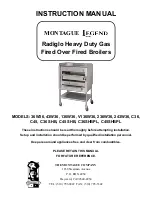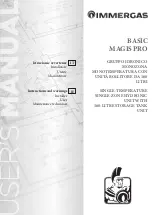
10
LP- 325 REV. 3.3.15
Consider appliance piping and installation when determining appliance location. Do not place the appliance in an area where it will be
prone to freezing.
To winterize the appliance, drain the entire system. Pump two gallons of non-toxic, NSF food grade, FDA rated GRAS (Generally
Recognized As Safe) propylene glycol into the tank. Consult the glycol manufacturer for specific instructions on concentration
percentage as well as freeze and burst protection methods. Check the concentration of antifreeze to assure protection is adequate to
protect the bottom of the appliance from freezing.
NOTE:
Damages resulting from incorrect installation or from use of products not approved by HTP, Inc. ARE NOT covered by warranty.
PART 2 – BEFORE YOU START
A. WHAT’S IN THE BOX
Also included with the appliance:
Pressure and Temperature Gauge
30 psi Temperature and Pressure Relief Valve
Intake PVC Tee with Screens
Exhaust PVC Coupling with Screens
Installation Manual
Warranty
Outdoor Sensor (Part # 7250P-319)
B. HOW THE APPLIANCE OPERATES
Condensing Technology maximizes efficiency by measuring the needs of your heating system through the use of sensors and a control
unit. The appliance uses data gathered by these sensors to intelligently deliver highly efficient hydronic heating.
Heat Exchanger
The highly efficient combustion heat exchanger flows exhaust gas through the primary section into the secondary heat exchanger
section, where the coldest water on the bottom of the tank extracts the last residual amount of energy.
Modulating Combustion System
Modulation during central heating operation is based on the supply temperature. The set point used for the control depends upon the
programmed central heating curve. The slope of the heating curve can be changed by the installer. The control monitors the system,
regulating burner output during operation to match system demand, effectively increasing efficiency and providing substantial fuel
savings.
Gas Valve
The gas valve senses suction from the blower, allowing gas to flow only if combustion air is flowing.
Swirl Plate System
The Swirl Plate on the gas valve controls air and gas flow into the burner, assuring better mixing for improved combustion.
Combination Top High Temperature Sensor
This sensor monitors supply temperature. The control module adjusts appliance firing rate, correcting supply temperature.
Bottom Water Temperature Sensor
This sensor monitors return water temperature. The control module reduces or increases appliance input accordingly.
Temperature and Pressure Gauge
Allows the user to monitor system temperature and pressure.
Control
The integrated control system monitors return and supply water temperature. The control system regulates the unit’s BTU output by
controlling fan speed, allowing the unit to deliver only the amount of heated energy required.
Burner
Constructed with metal fiber and stainless steel, the burner uses pre-mixed air and gas, providing a wide range of firing rates.
Electrical Field Connections with Terminal Strips
The cabinet allows easy access to the line voltage and low voltage terminal strips, which are clearly marked to facilitate wiring to the
appliance.
Содержание Pioneer
Страница 17: ...17 LP 325 REV 3 3 15 Figure 3 Dimensions ...
Страница 28: ...28 LP 325 REV 3 3 15 Figure 9 DHW Pack Performance on 199K BTU Models ...
Страница 44: ...44 LP 325 REV 3 3 15 Figure 20 ...
Страница 47: ...47 LP 325 REV 3 3 15 Figure 22 Internal Wiring Diagram ...
Страница 67: ...67 LP 325 REV 3 3 15 Figure 30 Pioneer and Versa Flame ...
Страница 68: ...68 LP 325 REV 3 3 15 Figure 31 Pioneer and Versa Flame ...
Страница 71: ...71 LP 325 REV 3 3 15 ...
Страница 72: ...72 LP 325 REV 3 3 15 ...











































